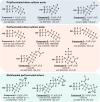Uncovering per- and polyfluoroalkyl substances (PFAS) with nontargeted ion mobility spectrometry-mass spectrometry analyses
- PMID: 37878714
- PMCID: PMC10599621
- DOI: 10.1126/sciadv.adj7048
Uncovering per- and polyfluoroalkyl substances (PFAS) with nontargeted ion mobility spectrometry-mass spectrometry analyses
Abstract
Because of environmental and health concerns, legacy per- and polyfluoroalkyl substances (PFAS) have been voluntarily phased out, and thousands of emerging PFAS introduced as replacements. Traditional analytical methods target a limited number of mainly legacy PFAS; therefore, many species are not routinely assessed in the environment. Nontargeted approaches using high-resolution mass spectrometry methods have therefore been used to detect and characterize unknown PFAS. However, their ability to elucidate chemical structures relies on generation of informative fragments, and many low concentration species are not fragmented in typical data-dependent acquisition approaches. Here, a data-independent method leveraging ion mobility spectrometry (IMS) and size-dependent fragmentation was developed and applied to characterize aquatic passive samplers deployed near a North Carolina fluorochemical manufacturer. From the study, 11 PFAS structures for various per- and polyfluorinated ether sulfonic acids and multiheaded perfluorinated ether acids were elucidated in addition to 36 known PFAS. Eight of these species were previously unreported in environmental media, and three suspected species were validated.
Figures




References
-
- Buck R. C., Franklin J., Berger U., Conder J. M., Cousins I. T., de Voogt P., Jensen A. A., Kannan K., Mabury S. A., van Leeuwen S. P., Perfluoroalkyl and polyfluoroalkyl substances in the environment: Terminology, classification, and origins. Integr. Environ. Assess. Manag. 7, 513–541 (2011). - PMC - PubMed
-
- Lindstrom A. B., Strynar M. J., Libelo E. L., Polyfluorinated compounds: Past, present, and future. Environ. Sci. Technol. 45, 7954–7961 (2011). - PubMed
-
- Rahman M. F., Peldszus S., Anderson W. B., Behaviour and fate of perfluoroalkyl and polyfluoroalkyl substances (PFASs) in drinking water treatment: A review. Water Res. 50, 318–340 (2014). - PubMed
Grants and funding
LinkOut - more resources
Full Text Sources

